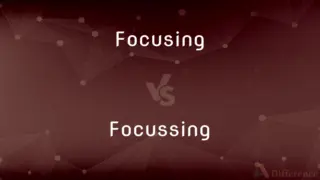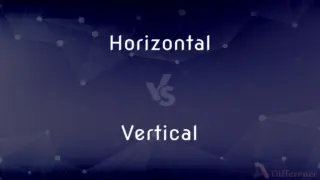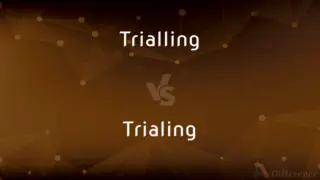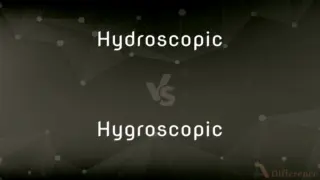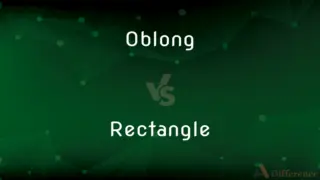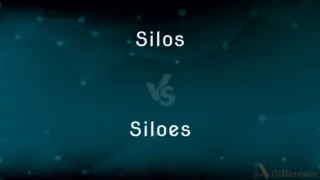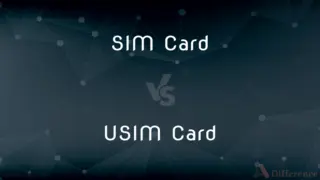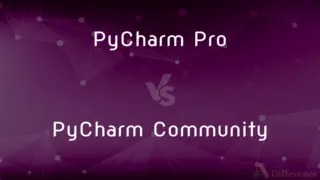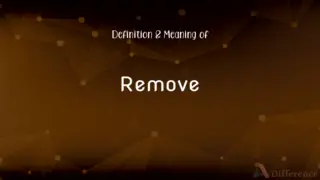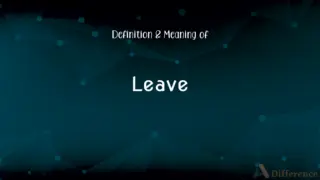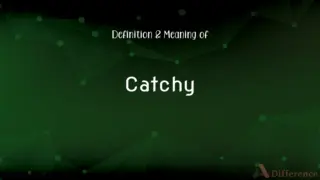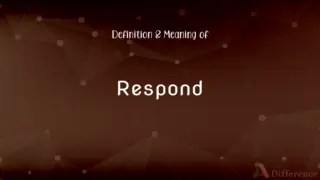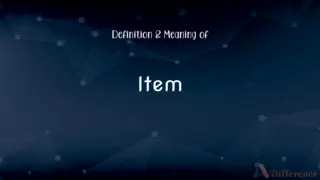Tentacles vs. Arms — What's the Difference?
By Tayyaba Rehman — Published on November 17, 2023
Tentacles are flexible, elongated appendages found in animals like octopuses and jellyfish, while arms are the upper limbs in humans and some animals used for various functions like grasping.

Difference Between Tentacles and Arms
Table of Contents
ADVERTISEMENT
Key Differences
Tentacles, in a biological context, refer to elongated, flexible appendages present in various animals, especially marine creatures such as octopuses, jellyfish, and anemones. These tentacles are often equipped with suckers or specialized cells that can sting or grasp. On the other hand, arms are the upper limbs found in humans and other primates, designed for various tasks like lifting, grasping, and manipulating objects.
While tentacles are primarily known for their sensory or predatory roles in the animal kingdom, arms serve a broader range of functions in humans, from physical tasks to gestures in communication. Tentacles, in most marine animals, aid in movement, capturing prey, and defense, utilizing specialized features. Arms, however, boast a skeletal structure, allowing for strength, precision, and a wide range of motion.
Tentacles are commonly associated with creatures of the ocean, while arms are prevalent in land-dwelling creatures. Furthermore, the term "arm" in marine biology can sometimes refer to limbs of specific sea creatures like starfish, but it's distinct from tentacles. While tentacles are more about flexibility and elongation, arms emphasize strength and manipulation.
Lastly, from a linguistic perspective, "tentacles" might evoke imagery of underwater creatures and mystery, whereas "arms" are often associated with strength, humanity, and daily tasks.
Comparison Chart
Definition
Elongated, flexible appendages in some animals.
Upper limbs in humans and some animals.
ADVERTISEMENT
Presence
Common in marine creatures like octopuses and jellyfish.
Found in humans and other primates.
Function
Sensory, movement, capturing prey.
Lifting, grasping, manipulating objects.
Structure
Lack bones, often with suckers or stinging cells.
Contains bones, muscles, and joints.
Associations
Oceanic, mystery, flexibility.
Strength, humanity, everyday tasks.
Compare with Definitions
Tentacles
Tentacles aid in movement and interaction.
Cuttlefish use tentacles to explore their surroundings and capture food.
Arms
Arms have a skeletal structure supporting muscles and skin.
The muscles in his arms were well-defined from regular workouts.
Tentacles
Tentacles often possess specialized cells or features.
The octopus's tentacles have suckers to grasp objects and prey.
Arms
Arms are equipped with hands for grasping and manipulation.
He used his arms to lift the heavy box.
Tentacles
Tentacles are elongated, flexible extensions in some animals.
Jellyfish use their tentacles to sting and immobilize prey.
Arms
In some animals, arms refer to limbs used for movement.
The monkey used its arms to swing between trees.
Tentacles
Tentacles are predominantly found in marine animals.
Anemones sway their tentacles to catch passing plankton.
Arms
Arms are the upper limbs in humans used for varied tasks.
She raised her arms to reach the top shelf.
Tentacles
Tentacles serve sensory and predatory roles.
Some animals have tentacles equipped with taste buds to sense their environment.
Arms
An upper limb of the human body, connecting the hand and wrist to the shoulder.
Tentacles
An elongated flexible unsegmented extension, as one of those surrounding the mouth of a sea anemone, used for feeling, grasping, or locomotion.
Arms
A part similar to a human arm, such as the forelimb of an animal or a long part projecting from a central support in a machine.
Tentacles
One of these structures in a cephalopod, typically being retractile and having a clublike end usually with suckers or hooks, in contrast to an arm, which is nonretractile and typically has suckers along the underside.
Arms
Something, such as a sleeve on a garment or a support on a chair, that is designed to cover or support the human arm.
Tentacles
(Botany) One of the sensitive hairs on the leaves of certain insectivorous plants, such as a sundew.
Arms
A relatively narrow extension jutting out from a large mass:an arm of the sea.
Tentacles
A similar part or extension, especially with respect to the ability to extend influence, activity, or control
An espionage network with far-reaching tentacles.
Arms
An administrative or functional branch, as of an organization.
Tentacles
Plural of tentacle
Arms
Power or authority:the long arm of the law.
Arms
(Sports)The skill of throwing or pitching a ball well.
Arms
A weapon, especially a firearm
Troops bearing arms.
ICBMs, bombs, and other nuclear arms.
Arms
A branch of a military force
Infantry, armor, and other combat arms.
Arms
Warfare
A call to arms against the invaders.
Arms
Military service
Several million volunteers under arms.
The profession of arms.
Arms
(Heraldry) Bearings.
Arms
Insignia, as of a state, an official, a family, or an organization.
Arms
To supply or equip oneself with weaponry.
Arms
To prepare oneself for warfare or conflict.
Arms
To equip with weapons
Armed themselves with loaded pistols.
Arm a missile with a warhead.
Arm a nation for war.
Arms
To equip with what is needed for effective action
Tax advisers who were armed with the latest forms.
Arms
To provide with something that strengthens or protects
A space reentry vehicle that was armed with a ceramic shield.
Arms
To prepare (a weapon or electronic system, such as an alarm) for use or operation, as by releasing a safety device.
Arms
Weaponry, weapons
Arms
(heraldry) A visual design composed according to heraldic rules, consisting of a coat of arms normally displayed upon an escutcheon, sometimes accompanied by other elements of an achievement
The arms of England are: gules, three lions passant gardant or.
Arms
Plural of arm
Arms
Instruments or weapons of offense or defense.
He lays down his arms, but not his wiles.
Three horses and three goodly suits of arms.
Arms
The deeds or exploits of war; military service or science.
Arms
Anything which a man takes in his hand in anger, to strike or assault another with; an aggressive weapon.
Arms
The ensigns armorial of a family, consisting of figures and colors borne in shields, banners, etc., as marks of dignity and distinction, and descending from father to son.
Arms
The legs of a hawk from the thigh to the foot.
Arms
Weapons considered collectively
Arms
The official symbols of a family, state, etc.
Arms
Arms are integral to human physical expression and gestures.
She folded her arms across her chest, signaling her displeasure.
Common Curiosities
What is the primary function of arms in humans?
Arms in humans are used for tasks like lifting, grasping, and manipulating objects.
Do arms always refer to human limbs?
Primarily, yes, but in marine biology, arms can also refer to limbs of creatures like starfish.
Are tentacles and arms the same in octopuses?
No, octopuses have arms; the term "tentacle" is a misnomer in popular culture.
What animals typically have tentacles?
Animals like octopuses, jellyfish, and anemones often have tentacles.
Do tentacles have bones?
No, tentacles typically lack bones and are highly flexible.
Can tentacles sting?
Yes, certain animals like jellyfish have tentacles with stinging cells.
How many arms do humans have?
Humans typically have two arms.
What's the difference in function between tentacles and arms?
Tentacles often serve sensory or predatory roles, while arms emphasize strength and manipulation.
Are arms used for defense?
In humans, arms can be used defensively, but their primary functions are varied.
Why are tentacles often associated with mystery?
Tentacles are common in elusive marine creatures, leading to a sense of oceanic mystery.
Are tentacles exclusive to marine life?
Predominantly, yes, but some land animals, like certain snails, also have tentacles.
Do all animals with arms have hands?
No, not all animals with arms have hands; it's a feature primarily in primates.
Can tentacles regenerate?
In some animals like starfish and octopuses, tentacles or arms can regenerate.
How do tentacles aid in animal movement?
Tentacles can help some animals move, capture food, or interact with their environment.
How do arms assist in communication?
Arms aid in gestures, which are vital for non-verbal communication.
Share Your Discovery

Previous Comparison
Fashion Show vs. Beauty Pageant
Next Comparison
Euro Currency vs. Pound CurrencyAuthor Spotlight
Written by
Tayyaba RehmanTayyaba Rehman is a distinguished writer, currently serving as a primary contributor to askdifference.com. As a researcher in semantics and etymology, Tayyaba's passion for the complexity of languages and their distinctions has found a perfect home on the platform. Tayyaba delves into the intricacies of language, distinguishing between commonly confused words and phrases, thereby providing clarity for readers worldwide.

